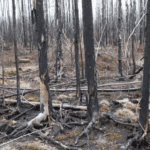Canadian Science Publishing welcomes Dr. Ellen Macdonald as the new Editor of the Canadian Journal of Forest Research. Dr. Macdonald is a professor and department chair for renewable resources at the University of Alberta, and she teaches a class on forest ecosystems. Her research is focused primarily on plant communities in the boreal forest.
How did you end up studying northern ecosystems?
I’ve focused on northern ecosystems throughout my research career. Starting in my undergrad, I did a Bachelor of Science in environmental biology at the University of Calgary, and I began working as an undergrad researcher at the end of my first year. I started working in northern ecosystems in Alberta. I just continued with my PhD and most of my field work was in Alberta and northern Saskatchewan. In my post-doc, I studied forest ecosystems specifically. I became interested in questions on how to sustainably manage our forests. And now, it’s 30 years later.

(Photo | Ellen Macdonald)
Why is the boreal forest important?
The boreal forest the largest forested biome in the world. It goes around the entire globe. It’s one of the least impacted forests by human activity—that’s not to say it isn’t impacted. To me, it still holds a lot of promise of being managed in a sustainable way. There’s lots we need to learn about it. It’s associated with particular climates. In general, it’s cold and trees grow slowly. Patterns of biodiversity in the boreal are different than in a tropical forest. Tropical forests have lots of tree species and the boreal has fewer, but the boreal has a high plant biodiversity. It’s important ecologically, economically, and socially. There’s still lots to learn about it.
What are some upcoming challenges facing the boreal forest?
The diversity of uses by humans and extracting timber in some parts of the boreal and extensive oil and gas activity. That’s not throughout the entire boreal forest, but in regions of Alberta that’s an issue. Lots of trees get cut down for that activity.
Climate change is also important. It can impact natural disturbance regimes. Wild fires, for example, become more severe and frequent because of climate change. Insect and pathogen outbreaks can also become more severe and spread into new regions.
What advice would you give to the next generation of researchers in the boreal forest?
Go to the forest. I’m a big fan of learning by being out there instead of analyzing data that someone else collected. There’s a lot to be learned by seeing and being in the forest and experiencing it for yourself. Questions will come to mind when you’re out there. Like why is this happening?
A lot can be learned by being out there and by people that have spent their whole lives out there. People that have lived there, such as Aboriginal people, have a history of interreacting with the land and have knowledge to help us move forward and manage the forest sustainably.
Are there more specific areas in plant science that you specialize in?
I have a lot of interest in understory plant research. I mostly research vascular plants [and have conducted] some research in bryophytes, which are mosses and liverworts. Any of the plants that live in the understory, that’s where the vast majority of biodiversity in the boreal forest is. All the plant species that live in the forest are of interest to me.




